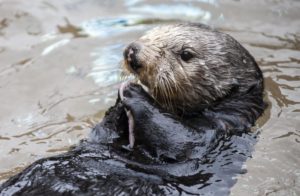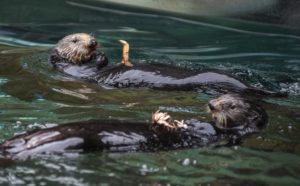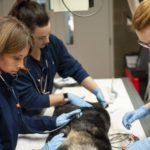She’s calm and confident– and loves her breakfast.
Moea (pronounced “Mia”) is the newest sea otter at Point Defiance Zoo & Aquarium, and she’s already settling into life at the Rocky Shores habitat with our other otters Libby and Sekiu. She’ll make her official debut with them Jan. 5 and 6, with special sea otter keeper talks at 10:30am both days.
Rescued to a new home

Around 10 years old, Moea came to the Zoo in early December. A Southern sea otter, she’d been rescued from an oil spill and rehabilitated at the Monterey Bay Aquarium, but after being released the little otter kept returning. Her liking for human company could be a danger to her in the wild.
Both Southern sea otter Libby and Northern sea otter Sekiu are also non-releasable: Libby, 7, was rescued after being found abandoned at just 24 hours old, while Sekiu, 6, was born at Seattle Aquarium.
“We are thrilled that Moea is now a part of our Point Defiance Zoo & Aquarium family,” said Malia Somerville, Rocky Shores curator. “Providing a second chance for rescued animals is one way zoos and aquariums can help save species.”
Moea has been living behind the scenes since her arrival, undergoing a complete wellness exam by the Zoo’s veterinary team. Her eyes, ears, nose, heart, lungs and abdomen were all checked, as well as vital signs and samples of blood, urine and feces.
Keepers then worked to introduce her gradually to both Libby and Sekiu, and get all three otters comfortable with each other.
Friends and food

Now, Moea’s fully settled into her new home.
“She’s a pretty easy-going and calm otter, confident around her caregivers and curious to explore her habitat,” said Somerville. “She enjoys her food and enrichment.”
And her favorite food?
“Right now it’s mussels, with crab coming a close second,” said Caryn Carter, senior staff biologist at Rocky Shores.
Even her name is food-related – a contraction of the scientific name for “sweet potato.”
Adorable – and endangered
Sea otters rely on their thick fur to keep them insulated and warm, grooming it often to keep it waterproof. When it gets coated with something they can’t clean off themselves – like oil – they can lose the warmth they need to stay alive in cold North Pacific waters.
Preferring coastal waters, sea otters can be found from Alaska to California. They are endangered, having once been hunted nearly to extinction for their fur. (It’s the densest of any mammal, with up to one million hairs per square inch.) Otters are still at great risk from oil spills, parasites that wash into the ocean from storm drains, and plastic ocean trash.
They are vital for the health of coastal ecosystems, particularly kelp forests like those of Puget Sound and Monterey Bay, as they love to eat the purple sea urchins that would otherwise devour these forests completely.
Sea otters are very social creatures, living in groups of up to 100 in the wild. The otters at Point Defiance Zoo & Aquarium are no exception: Libby and Sekiu love to play, swim and cuddle with each other.
A sweet reunion

But when Moea arrived, she already had a friend – a human one.
In a happy coincidence, veterinary technician Lauren Miele, who assisted at her wellness exam, had actually worked with the otter before at Monterey Bay.
“She’s so lovely!” said Miele, cleaning Moea’s teeth during the exam. “Whenever I walked past her habitat she was always the one lifting up her head to say hi! I’m so excited we’re together again.”
-Rosemary Ponnekanti, PDZA